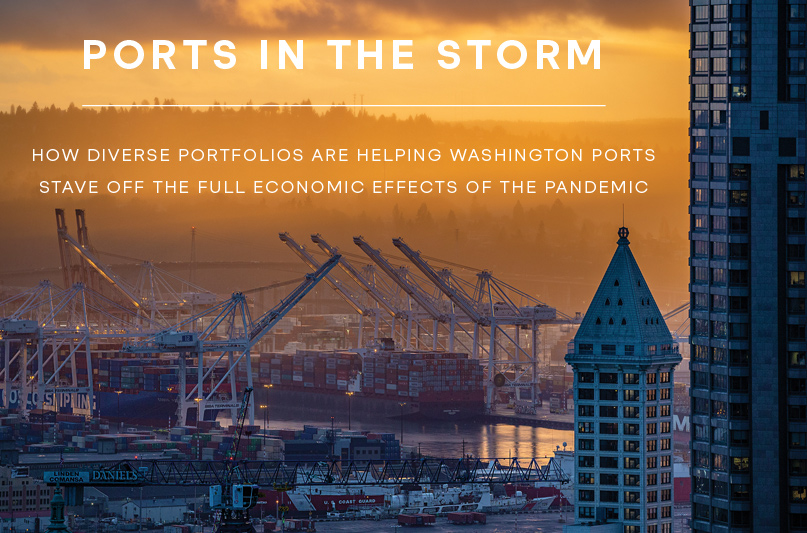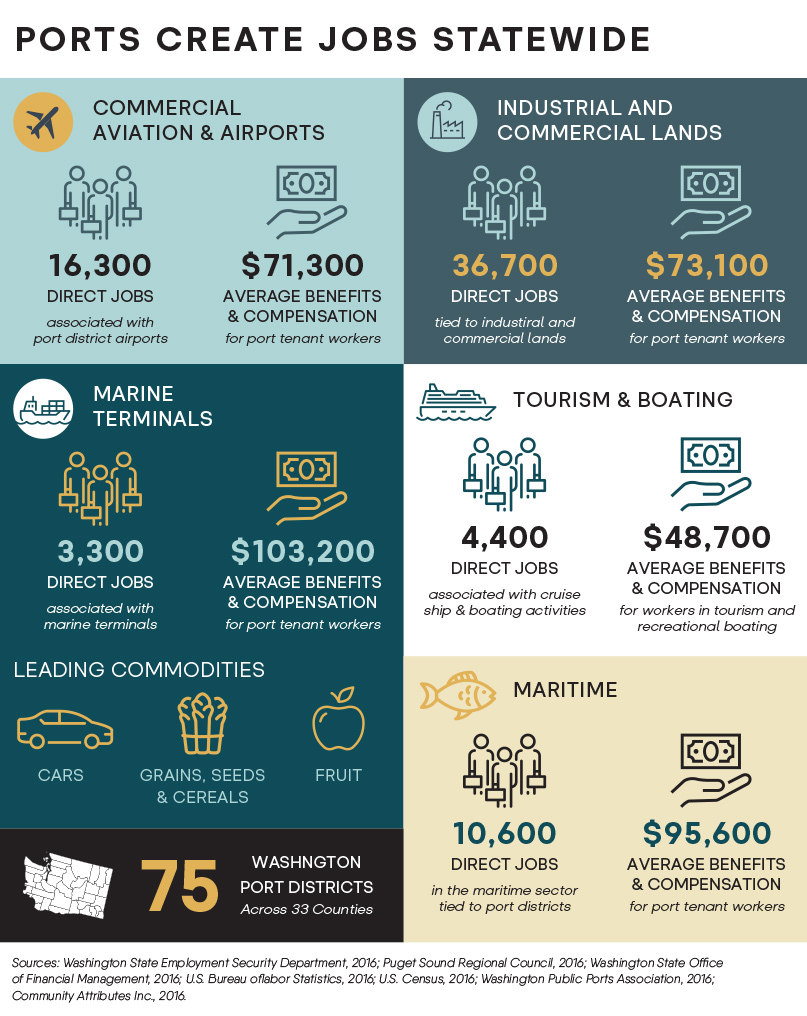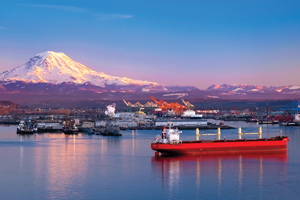
 The Port of Seattle, like many ports in Washington, is taking a big hit from the COVID-19 pandemic. Travel in and out of Seattle-Tacoma International Airport, owned by the Port of Seattle, is down 90-95%, port spokesman Peter McGraw said. Cruise ship travel, which pumps $900 million a year into the local economy, is at a standstill.
The Port of Seattle, like many ports in Washington, is taking a big hit from the COVID-19 pandemic. Travel in and out of Seattle-Tacoma International Airport, owned by the Port of Seattle, is down 90-95%, port spokesman Peter McGraw said. Cruise ship travel, which pumps $900 million a year into the local economy, is at a standstill.
Yet the Port of Seattle’s diverse portfolio is enabling the port district to stave off the full force of the pandemic-induced economic storm. A diverse portfolio means diverse sources of revenue for the port besides transportation: property tax levies, lease and rental fees, charges for services and the use of land and other facilities, proceeds from bonds sold for capital project construction, and grants.
Like a smart stock investor, the port owns some investments that are holding steady while others decline. The Port of Seattle is benefitting from 100 years of wise investment and its important location for global trade.
The Northwest Seaport Alliance, a port authority created by the Ports of Seattle and Tacoma – operates a container complex that is the third-largest in North America and, according to the World Shipping Council, the 41st largest in the world.
The Port of Seattle owns World Trade Center West, with 5,777 square feet of office space; Terminal 106 Building, an 18,800-square-foot warehouse; nearly two acres of industrial land; Fishermen’s Terminal; Harbor Marina Corporate Center; the Maritime Industrial Center; Shilshole Bay and Salmon Bay marinas; and four other maritime properties. Shilshole Bay Marina has what is touted to be the largest liveaboard community on the West Coast.
Now, as the spread of the COVID-19 virus slows and testing becomes more available, the Port of Seattle is moving ahead with major capital projects to keep people employed and bolster the post-pandemic economic rebound. “Our primary focus is economic development and jobs,” said Peter Steinbrueck, president of the Port of Seattle Commission. “At our airport, seaport, terminals and marinas, we are going to be an important resource in recovery. [The economy] is deep in this malaise right now, but we’re going to minimize the economic impact of the pandemic and bolster our businesses’ ability to rebound.”
The Port of Seattle is not alone. Economic diversity is helping many of Washington’s 75 voter-created port districts weather the downturn caused by COVID-19. The Evergreen State is a gateway to the Pacific Rim. If it’s made, grown, or refined in Washington — whether aircraft engines, ag products, or petroleum — its journey to overseas markets begins at a port. According to the state Department of Commerce, Washington is the fourth-largest exporting state in the United States — after New York, California, and Texas. Washington’s ports handle 8% of all U.S. exports and receive 6% of the nation’s imports.

Left: Aviation is a component of ports as diverse as Camas-Washougal and Seattle. During the pandemic, much needed infrastructure improvements have continued at SeaTac Airport, and cargo has continued to flow (Photo: Alex Kwanten). Right: The Port of Everett includes trade operations and consumer services – including a vast marina. (Photo: Cindy Shebley)
“Trade through Washington ports for the first three months of the year was relatively even, averaging about $12 billion a month with March recording the highest figure,” said Penny Thomas, spokeswoman for the state Department of Commerce. “This suggests that the impact of COVID can’t really be seen in the data at this point.”
Washington’s port districts also develop land for industrial and commercial needs; buy, lease and sell property; establish and operate foreign trade zones; promote tourism; subsidize space for start-up businesses; and own and operate cold storage, log-export yards, and boat launch ramps.
Here’s a look at how several port districts are responding to the pandemic.
The Port of Seattle Commission is using the pandemic-induced slowdown to accelerate capital development projects to help fuel recovery once the pandemic ends. The $1.5 billion in capital development will directly generate an average of 700 full-time construction jobs per month, or 1,300 full-time and part-time jobs, according to the Port’s website – not including 1,100 more indirect jobs through a network of suppliers and construction support.
To assist its tenants and prepare for recovery, the Port of Seattle:
- Barred eviction of port tenants.
- Deferred business rents for the months of April through July.
- Deferred moorage fees for liveaboard and other moorage customers for the months of April through June.
- Obtained $192 million in grant funding from the U.S. Department of Transportation as part of the CARES Act to offset financial damage caused by the reduction of air travel.
- Is proceeding with modernization and expansion of the north terminals at SeaTac International Airport.
- Is proceeding with expansion of SeaTac’s International Arrivals terminals.
- Is proceeding with replacement of SeaTac’s passenger loading bridges and improvements to the airfield pavement.
- Is proceeding with replacement of the north berth at Terminal 46.
- Postponed construction of an additional cruise terminal that had been proposed at Terminal 46. “With global cruising on pause right now, it’s appropriate that we consider coming back to this project in the future when we have a clearer picture of the market,” Port Executive Director Steve Metruck said on the Port’s website.
- Some businesses at Fisherman’s Terminal remained open and operating under proper protocols to serve the North Pacific fishing fleet. Terminal 91 remained open as well — moorage, storage and equipment services — to the commercial fishing fleet.
“As one of the largest public-sector builders in the region, the Port is uniquely positioned to help lead the region’s recovery,” Steinbrueck said. “Our goal is to help keep construction workers employed by providing certainty to large public works construction projects, accelerating some projects where feasible, and by supporting our private-sector partners.”
The Port of Seattle’s 2020 operating budget is $470 million; its 2020 capital budget is $640 million, according to information provided by port spokesman McGraw. “Our diversified portfolio helps keep these [capital] projects moving,” McGraw said.
The Port of Everett owns and operates a seaport with eight shipping berths and is the state’s third-largest container port. The Port owns and operates the largest public marina on the West Coast and owns 3,000 acres of waterfront property.
The Port of Everett has a $102 million operating and capital budget and supports more than 35,000 jobs in the region. Sixty percent — or 3 out of 5 jobs — in Snohomish County are tied to trade.
To keep the economic engine running, the Port of Everett:
- Established a COVID response team.
- Advocated on the federal and state level for relief funding.
- Advocated for federal infrastructure financing to keep projects moving forward.
- Deferred capital projects.
- Instituted a hiring freeze.
- Provided rent relief to commercial tenants and moorage relief upon application and approval.
- Prepared a return-to-work strategy.
- Put in place an economic recovery plan to facilitate, now and in the future, “a more rapid economic recovery, job replacement, and continuing economic development in furtherance of the Port’s fundamental purpose.”
- Supported innovation that emerged in response to the pandemic, for example, procuring gallons of hand sanitizer created by a local distillery.
While marina operations have been modified, the Port’s seaport remains in full operation.

The Port of Camas-Washougal, on the Columbia River, owns a 350-slip marina, Grove Field airport, an industrial park, and parks and trails.
“[The marina] serves more than 7,000 boats every year,” according to the Port’s website. “The Port is home to 54 businesses [and] produces over six jobs for each acre of land it leases.
There are 19 buildings totaling nearly 300,000 square feet on Port property with an occupancy rate of 100%.”
To keep its economic engine moving and plan for post-pandemic recovery, the Port of Camas-Washougal:
- Established a rent relief program for port tenants.
- Continued planning the development of its Waterfront at Parker’s Landing, a 20-acre riverfront community of commercial, retail, residential and mixed uses. Final design of Phase 1 will be completed in mid- to late-2020, with plans to break ground in 2021.
- Is proceeding with slurry sealing of the airport runway and taxiway.
- Kept its boat launch open, while reducing the number of launch and retrieval lanes to two to ensure proper social distancing.
The Port of Kalama, on the Columbia River, owns a 22-slip marina, park and amphitheater; a marine terminal, business park, and facilities for manufacturing and warehousing; and developable industrial land. More than 30 companies, employing more than a total of 1,000 people, lease Port land.
The Port of Kalama Commission:
- Delegated to the Port executive director limited authority to amend leases.
- Surveyed its business tenants and clients to assess economic impacts and needs.
- Approved rent forgiveness and rent-forbearance agreements, depending on need. The latter spreads two months’ rent out over two years.
- Kept the marina and parks open, but closed playgrounds and canceled scheduled events to prevent the spread of the virus.
- Limited in-office work by Port employees.
The Port reports that terminal operations continue and cargo handling remains steady but slower because of enhanced safety.
The Port of Kingston, on the Kitsap Peninsula, owns the Port of Kingston Marina, SaltAir Beach, the waterfront Mike Wallace Park, and land leased by the Washington State Ferries for the Kingston/Edmonds ferry landing.
The Port of Kingston responded quickly to the pandemic:
- Closed port offices; all port employees are working remotely.
- Kept marina restrooms and laundry open to marina liveaboards.
- Kept the fuel dock open, though customers must call first for availability.
- Reviewed and revised its 2020 budget.
- Reviewed and updated all contracts.
- Conducted a risk assessment, inventoried assets, and prioritized its capital projects.
- Examined options for rent and rate relief for port tenants.
- Reevaluated its goals for 2020 and its five-year plan.
Washington’s ports, long a symbol of recreation, transportation and trade in the Evergreen State, may soon be remembered for their role in bolstering the state’s economic rebound from the COVID-19 pandemic. Gov. Jay Inslee once said of ports: “Washington relies heavily on international trade, the competitiveness of the ports and the good-paying jobs that keep freight moving.”
The Little Guy: Port of Elgon
You won’t find a marina or trade center at the Port of Eglon, and the only commerce that takes place here might involve farm products or the annual arts and crafts bazaar in the historic Eglon School, which is now a community center.
Today, the Port consists of a boat ramp, a small park, and about 100 feet of beach. There are three port commissioners, all who typically run unopposed in the elections. The district collects about $20,000 a year in property taxes. There was no economic impact from the COVID-19 virus except, perhaps, for the cost of signage reminding people to maintain social distancing.
However, the Port of Eglon has a rich history.
Established in 1919 by Eglon voters, the Port was a gateway to the peninsula before the rural community was connected to to the rest of the county by road. Mosquito fleet ferries delivered people and goods at the Port dock, built next to a post office, store, and warehouse. One Port commissioner had the job of furnishing the coal oil for the night light on the dock.
The state highway was completed in 1924, making vehicle travel possible to and from Eglon. By the early 1940s, the dock was no longer used for its original purposes and fell into disuse. The Port evolved into the boat launch, beach, and park.
Port officials and residents have fiercely defended their independence since 1960, fending off efforts to consolidate Eglon and other small port districts in Kitsap County. Port of Eglon Commissioner George Coles was quoted at one time saying that residents didn’t want a dock or industry. “Leave us alone,” he said. “We don’t want to be infringed upon. We want to keep our little bit of beach and use it for the children to swim.” And now, in its 101st year, that’s exactly what the Port of Eglon is today.



